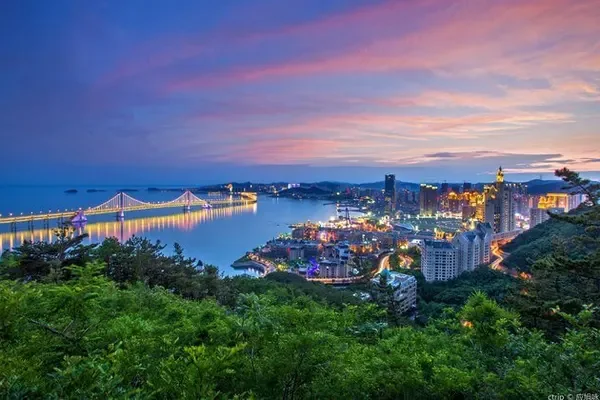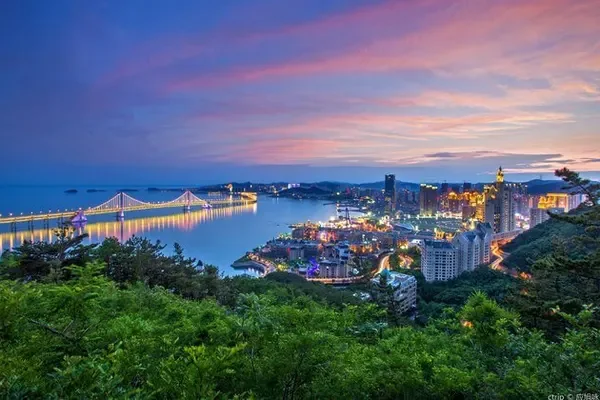Take a break and write down the old travel notes. The following is the Tanzhe Temple visited on New Year’s Day in 2019.
Tanzhe Temple is located at the foot of Tanzhe Mountain in the southwest of Mentougou District, Beijing, backed by Baozhu Peak and surrounded by nine peaks.
From the east, there are Huju Peak, Pengri Peak, Zicui Peak, Jiyun Peak, Yingluo Peak, Jiayue Peak, Elephant King Peak and Lianhua Peak. They are like nine dragons guarding them. The tall peaks block the cold current from the northwest. The place where Tanzhe Temple is located has formed a warm and humid microclimate, so the vegetation is luxuriant, the forests are verdant, there are many ancient trees and famous flowers, the temples are Chonghong, and the scenery is beautiful.
The ten sceneries of Tanzhe Temple are divided into red leaves on the plain, Nine dragons playing with pearls, thousands of peaks arching emerald greens, mountains and valleys piled up with clouds, temples and pavilions in the south, flowing cups in the imperial pavilion, Xiongfeng holding the sun, mountains and moons, Jinping snow waves, flying spring night rain.
The temple was first built in the first year of Yongjia in the Later Jin Dynasty (307), and it was originally named Jiafu Temple. It was called Longquan Temple in the Tang Dynasty, and it was named "Dawanshou Temple" in the Jin Dynasty. After the expansion in the 31st year of Kangxi in the Qing Dynasty (1692), it was named "Xiuyun Temple" by the emperor. Because there is a Longtan behind the temple, and there are a large number of Zhe trees on the mountain, the folk custom is called Tanzhe Temple.

The picture comes from the Internet
Tanzhe Temple has a long history and is a national key cultural relic protection unit. An old proverb says "Tanzhe first, then Youzhou", or "Tanzhe Temple first, then Beijing City".
During the Zetian period of the Tang Dynasty, the eminent monk Huayan came to Tanzhe Temple to build a mountain and built a temple. He held the "Huayan Sutra" as a pure karma. Tanzhe Temple became the first temple in Youzhou area with a confirmed sect, and Tanzhe Temple received prosperity.
During the Five Dynasties and the later Tang Dynasty, Zen Master Shi came to Tanzhe Temple to eradicate barren land and renovate the temple. The shadows flourished again. At that time, Tanzhe Temple also changed from Huayan sect to Zen sect.
Jin Xizong Wan Yanquan went to Tanzhe Temple to offer incense and worship Buddha in the first year of Huangtong (1141), and allocated funds to renovate and expand Tanzhe Temple. This is the first emperor who went to Tanzhe Temple to offer incense. Following suit, Jin Xizong changed the name of the temple at that time Longquan Temple to "Dawanshou Temple", allocated funds for large-scale renovation and expansion of Tanzhe Temple, and created a precedent for the emperor to give a name to Tanzhe Temple and the imperial court to fund the renovation of Tanzhe Temple. In the Jin Dynasty, Zen studies in Tanzhe Temple flourished, and its representative figure was Zen master Guanghui Tongli, master of Linji sect, Kaixing. Kaixing lived in the temple forever, and after his death, he was honored as a Zen master of "Guanghui Tongli" by Buddhism.
Princess Miaoyan, the daughter of Kublai Khan, the ancestor of the Yuan Dynasty, went to Tanzhe Temple to become a monk in order to atone for her father. After she lived in the temple, she knelt down and chanted scriptures in the Guanyin Hall every day, "repenting to Guanyin", and as time went by, she actually ground two deep foot sockets on a floor tile in the temple. Today, Princess Miaoyan's "brick worship" is still enshrined in the Guanyin Hall of Tanzhe Temple, and it is a very precious historical relic of Tanzhe. Master Hou Miaoyan died in the temple, and his tomb tower is in the lower pagoda courtyard in front of the temple.
In the early Ming Dynasty, Yao Guangxiao, an important official named Daoyan, helped the king of Yan Zhu Di "Jing Nan" seize the throne. After becoming famous, Yao Guangxiao resigned from office and went to Tanzhe Temple in the west of Beijing to practice in seclusion. A Zen master discusses Buddhism. When Beijing City was built, the designer was Yao Guangxiao. He got a lot of inspiration from the architecture and layout of Tanzhe Temple. Many places in Beijing City were built according to the appearance of Tanzhe Temple. It was built on the basis of the Daxiong Palace, the same as the roof of the hall with double eaves, and the ceiling at the mouth of the well is painted with golden dragons and seals, the difference is that it is taller. Later, Yao Guangxiao left Tanzhe Temple to preside over the compilation of "Yongle Dadian", but the ruins of the Shaoshi Jingshi where he lived in seclusion and practiced in Tanzhe Temple still exist today.

The buildings of Tanzhe Temple are roughly divided into three parts. Along the central axis of the middle road, there are archway, Jiefan bridge, Shanmen, Tianwang hall, Daxiong hall and so on. Pilu Hall, Guanyin Hall and other halls. There are Fangzhangyuan, Liubei Pavilion, Xinggongyuan and White Pagoda on the east road. There are Jie Altar, Shurangama Altar, and Great Compassion Altar on the west road, and there are Guanyin Hall, Manjusri Hall, Puxian Hall, and Dragon King Hall at the north end.

Outside Tanzhe Temple, the stone-built corridors are pitted by the annual rings of history and the chariots and horses, showing the vicissitudes of the ancient roads.

Zhe trees outside the mountain gate. Zhe tree grows in the south and is rare in the north. It has hard wood, fine texture and good elasticity of branches. It is a good material for making arches. Its roots, stems, bark, leaves and fruits can be used as medicine. In the past, there were "thousands of Zhe trees" in Tanzhe Temple, which were all over the mountains and fields, covering the sun with shade. Later, it was said that the bark of the Zhe tree in Tanzhe Temple could cure women's infertility, and people competed to peel it, which made the Zhe tree all over the mountain almost extinct, and only a few trees remain.

Outside the mountain gate is a wooden archway with 3 floors and 4 pillars, with the words "Cuizhang Danquan" written on it.

Fragrant Forest Pure Land


There are two ancient pine trees in front of the archway, the branches and leaves of which are connected to each other, like a green ceiling, and a pair of stone lions in front of the archway, majestic and mighty.

A few ancient trees outside the mountain gate have luxuriant branches and leaves, which are simple and vicissitudes, almost covering the entire mountain gate.

On the mountain gate of Tanzhe Temple, there are six characters on the arch in the middle, "Chijian Xiuyun Temple", written by Emperor Kangxi. The single-hole stone arch bridge in front of the mountain gate is named "Huaiyuan Bridge".
The second general of Haheng is shaped in the gate hall.


Offering incense sticks in front of the Palace of Heavenly Kings



The murals in the Hall of Heavenly Kings, four values of year, month, day and hour



Daxiong Palace. The treasure hall is five rooms wide, with double eaves on the roof, yellow glazed tiles and green trimmings, the upper eaves are inscribed with "Quiet and Solemn" by Kangxi's imperial pen, and the lower eaves are inscribed with "Fuhai Pearl Wheel". In the center of the hall is a huge statue of Buddha, with a solemn expression and a backlight behind it. The backlight is decorated with Dapeng Garuda, Dragon Girl, Lion, Elephant, Sheep, flame patterns, etc. The left and right of the Buddha statue are divided into "Ananda" and "Gaye" statues, all of which are relics of the Qing Dynasty.




The picture comes from the Internet


There is a large square behind the Daxiong Hall. There are two salsa trees and ginkgo trees at the four corners of the square. The ginkgo tree on the east side is the "emperor tree", which is one of the ten famous trees in China, and the west side is the "peiwang tree". When the ginkgo leaves are yellow in early winter, the scenery is the best.

Sala tree


Erqiao Magnolia is a hybrid of Magnolia and Magnolia. The tree is more than 400 years old. It has huge flowers with two colors, purple and white. People refer to it as Jiangdong Erqiao. There is a poem praising it: "In three springs, there is a wonderful view of the capital, and you can enjoy magnolia beside the white stone steps."


Pilu Pavilion, the temple rests on the branch of the Seventh Patriarch of Longtan to pass on the magic method, the mountains connect with Jiuling, nine peaks and emerald green surround the heavens.

Ksitigarbha Temple

The Vajra Longevity Pagoda and the Twin Phoenix Dance Pagoda.

West Road Building

Guanyin Cave at the northern end






Guanyin Hall

On the west side of the Avalokitesvara Hall is the Dragon King Hall. On the porch in front of the hall is a stone fish, 1.7 meters long and 150 kilograms in weight. .






Shurangama Altar

altar





Yi Xuan Pavilion

The curved water in the pavilion




In the Tiger Pagoda, the tiger who listened to scriptures was buried.


